by Greg Thompson
The AAO’s latest chief executive has devoted his life to orthodontics, service, and family
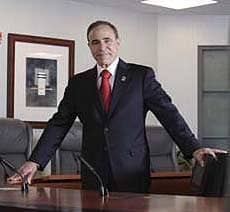
For Lee W. Graber, DDS, MS, PhD, the road to the AAO presidency began with a smile from his father. Other dads in the neighborhood came home weary from a difficult day, but Tom Graber, DMD, MSD, PhD, saw tough orthodontic cases in his private practice—and lectures at the university—as an invigorating opportunity to learn, create, and teach others.
As a boy growing up in the 1950s and 1960s, the younger Graber took his dad’s sunny countenance to heart, and the first seeds of a career began to grow. As the oldest child among four other siblings, Graber accompanied his father to professional meetings, where he found a diverse group that attested to orthodontics’ attraction among the best and brightest.
After attending Northwestern University, Graber enrolled in the University of Michigan School of Dentistry at a time when the university’s Center for Human Growth and Development, a multidisciplinary research and education unit, was just getting into action. The Center is still there, and, along with the dental school, plays annual host to the Moyers Growth Symposium, named after Robert E. Moyers, DDS, PhD, under whom Graber studied during dental school and graduate school.
Graber completed a master’s degree and his orthodontic education at Northwestern, and began practicing part-time with his dad in 1973 while also teaching full-time at Northwestern. Eager for more education, he returned full-time to the University of Michigan where he earned another master’s degree (in anatomy); a PhD (in human growth and development); and practiced part-time with Moyers, James A. McNamara, Jr, DDS, PhD, and Jack Mortell, DDS.
Graber’s next move was back to Chicago, where he was on the part-time faculty at Loyola University and again practiced with his dad for more than a decade. Tom Graber passed away almost 3 years ago. “Working with him was phenomenal because my dad was literally Mr Orthodontics,” says Graber, a past president of the World Federation of Orthodontists who becomes president of the AAO at this year’s Annual Session in Washington, DC. “They say, ‘Who wrote the book?’ My dad wrote one of those first books specifically for graduate orthodontic education, and we are now bringing out the fifth edition of what was originally his textbook. It remains one of the most-used textbooks in graduate orthodontics here and abroad. Experiencing orthodontics with my father after I got out of school was a priceless opportunity.”
PRACTICE PROFILE
Name: Lee W. Graber, DDS, MS, PhD
Practice Name: Graber Orthodontics
Location: Vernon Hills, Ill
Specialty: Orthodontics and dentofacial orthopedics
Years in private practice: 36
Days worked per week in private practice: 5 (4 in clinic and 1 administrative)
Office square footage: 2,800
Web site: GraberOrthodontics.com
A Third-Generation Practice
The Grabers have always had a multi-orthodontist practice, and at one point had offices in Chicago, Kenilworth, and Vernon Hills. “My dad and I always thought that two heads are better than one when diagnosing and treating patients,” Graber says. “We had a number of excellent orthodontists who worked with us, many of whom built their own practices. Santo Signorino, DDS, MS; Donn Chung, DDS, MSD; T.J. Aoba, DDS; Lawrence R. Voss, DDS; Gary Schuberth, DDS; Mart McClellan, DDS, MS; Rob Bard, DDS; and Patrick F. Foley, DDS, MSD, all contributed to treatment philosophies that addressed a broad spectrum of patients and allowed the freedom for us to participate in professional activities outside the office.”
In 1980, the Grabers embraced innovation and the office was fully computerized—at least by the standards of the time. Using technology to better serve patients and visualize treatment goals was always the idea. “We actually had a computer at each chair at that time, and that was a really novel thing,” Graber muses. “We had talked about visual treatment objectives, and so we would always try to put those out there for patients to see how they were changing, and use it as a motivational tool. Now management systems are comprehensive in all areas of practice, including patient education.”
Practicing with family members can admittedly be a dicey proposition, and both men frequently discussed ways to avoid generational clashes. Many years later, the tables would be turned when one of Lee Graber’s three daughters expressed interest in the dental profession. Now in her early 30s, Katie Graber, DDS, MS, is a full partner at Graber Orthodontics in Vernon Hills, Ill. Thanks to clear communication and mutual respect, things are running as smoothly as they once did when a youthful Lee Graber ran the practice with his father.
Even with solid roots, Graber encountered skepticism when he spoke about adding Katie to the practice. “I was counseled by a number of my colleagues to not bring my daughter in with me,” Graber says. “Their problem likely was they did not have a solid relationship [with their children] based upon mutual understanding and respect. Katie and I have a lot of fun in our practice. We freely discuss different ideas and approaches to treatment. She has her unique background, and I have mine, albeit we continue to share in a variety of continuing education meetings together. She is left-handed and I am right-handed, so we even look at teeth and faces from opposite sides—while developing common goals.”
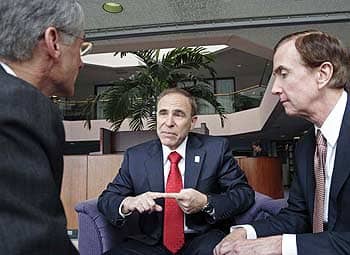
“Service as a volunteer leader with the AAO has provided the chance to work with outstanding colleagues both here and abroad,” Graber says.
With an orthodontist and dentist as parents, young Katie Graber could identify a bicuspid quicker than any child on her street. Lee Graber’s enthusiasm for orthodontics ultimately rubbed off on her, and now Katie is often in full charge as Graber travels the country and globe in his role as AAO president. “It’s true that when I am not in the office she is working extra hard to make sure that we maintain the highest level of care,” Graber says. “I was in the office just 3 days in February. She and her husband also take care of their 3-year-old son—my grandson—and my hats are off to her for her role as a young mom and a full-time professional.”
The downside is that business occasionally overtakes the family. That’s not surprising when you consider that Lee Graber has been practicing for 36 years and that his wife, sister, and brother-in-law are all dentists. When phrases from other family members such as “that sounds so distal” creep into dinner-table conversation, the oral health professionals at the Graber table know it’s time to rein it in for the benefit of the nondentists.
Spreading the Word
Ultimately, taking the best from new and old serves Lee and Katie Graber well. That spirit of learning is something Graber hopes to bring to his AAO presidency during a time when spreading knowledge is more important than ever. Encouraging and sponsoring research to advance the art and science of orthodontics is an element of the AAO mission that the new chief embraces with enthusiasm. Through AAO’s family of affiliated organizations, including the AAO Foundation, one of Graber’s priorities is to improve the recruitment and retention of educators and at the same time provide members with more learning opportunities, including a growing distance-learning program.
A comprehensive awareness campaign to educate the public about the benefits of orthodontic treatment continues to be a priority as well. AAO members have voted to allot money toward consumer education to make sure that potential patients know that orthodontists receive 2 to 3 years of additional postgraduate orthodontic education after finishing 4 years of undergrad work and dental school.
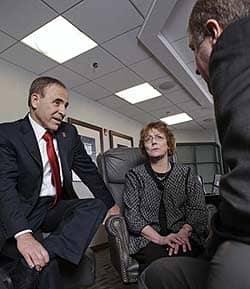
When asked about the AAO’s lobbying efforts, Graber says, “Most times we go on the Hill we are going with the same message in support of oral health care … the AAO will continue to get dentistry’s message out to the legislators.”
Viewing orthodontics as part of an overall dental health care program—not just a cosmetic luxury—is another priority. “When general dentists are considering what is best for their patients, we hope they think about orthodontics the same way they would consider other dental specialties,” Graber says. “They should be looking at alignment, occlusion, and those things that are going to involve orthodontics for that patient’s overall care. In addition to consumers, better educating our nonorthodontist dental colleagues is part of our education mission.”
A shortage of top-notch educators is a real problem that threatens the next generation of orthodontists, and AAO leadership responded this year with an afternoon session at the AAO Annual Session to allow junior faculty from various universities to outline the many challenges of academia—challenges that have fueled a drain of talent from the classroom to the private practice. Members of the AAO Task Force on Recruitment and Retention will take heed of the suggestions and seek to improve recruitment and retention of orthodontic educators. The efforts are part of a 4-year mission that has seen millions of dollars go to grants, fellowships, research, and training.
For orthodontists who need a push, the fellowships have a “payback” program. If an orthodontist gets a year of fellowship support, he or she is expected to do 1 or 2 years of payback working as a full-time academician to maintain those funds. Graber reports that the program has “purchased” decades of education.
To smooth collaboration—educational and otherwise—among related professions, Graber indicates that the AAO has sought to maintain alliances with the ADA to improve oral health in America. Graber thinks that patients are better served by these partnerships, and clout among legislators in Washington is undoubtedly buoyed.
Protecting the interests of small business owners on Capitol Hill is another item on Graber’s agenda, as is expanding options for patients to receive care. “Flexible spending accounts (FSAs) have been under attack in health care discussions on the Hill,” Graber says. “We have been supporting FSAs for patients so they can afford dental, vision care, diabetic supplies, and other crucial services.”
Lessening governmental burdens on small business, including keeping taxes low, is a principle that Graber hopes the AAO continues to champion during his stint as AAO president. He points out that purchasing and using new equipment is incredibly expensive these days, and clinicians don’t need extra financial obstacles. “The AAO retains a firm in Washington, DC, to represent our interests, and we will continue to do that,” Graber says. “Most times we go on the Hill we are going with the same message in support of oral health care that is being carried by the American Association of Oral and Maxillofacial Surgeons and the American Dental Association. So the AAO will continue to get dentistry’s message out to the legislators.”
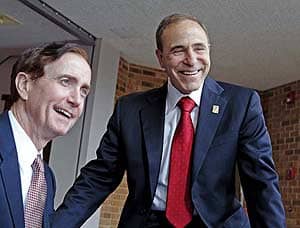
For those who lack insurance and/or can’t pay for orthodontic care, Graber will continue to encourage the AAO to support pro bono care, which members have already completed to the tune of $62 million annually. Five pilot programs in five states will explore the possibilities of providing necessary orthodontic treatments for those who don’t fall under government or insurance programs.
The Leadership Mantle
There are no guilt trips when Graber asks AAO members to get involved. Passion and infectious enthusiasm are the tools he uses to urge colleagues to be seen and heard within the community. He is confident the younger generation will step in to the leadership roles when the time comes. “Some have said the younger generation doesn’t want to serve, but that is not the case,” Graber says. “Some of our younger members may not know that there is a reason and a purpose for serving. For my generation, being involved was just as important as having your license to practice. Today’s younger members are asking: ‘Why should I do this?’ When they find out, they certainly will step up to the plate. We heard statistics on volunteerism, and the younger generations are volunteering at the same, if not greater, rates than people in my generation. As liaison to our AAO Council on New and Younger Members this past year, I am assured our association has a strong future with volunteer leaders.”
According to Graber, the AAO’s biggest educational asset is the Annual Session, where more than 250 speakers deliver lectures on all areas that impact orthodontics. Recent attendance figures back up the claim, with a large percentage of members electing to make the trip.
A whopping 95% of educationally eligible orthodontists ultimately join the AAO, a figure that Graber says attests to the organization’s value proposition.
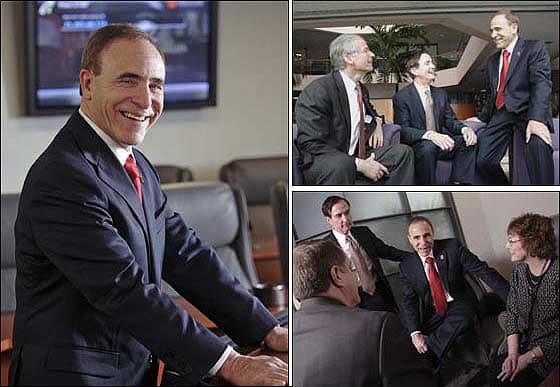 |
“Service as a volunteer leader with the AAO has provided the chance to work with outstanding colleagues both here and abroad,” he says. “In those first years in dental school, and even as an orthodontic resident, I never could have dreamed of the opportunities with which I have been blessed.”
While this year figures to be a whirlwind, Lee Graber has been known to spend time windsurfing the waters of Wisconsin’s Lake Geneva, but he mostly spends his limited downtime with family or reading books. He’s rereading Bram Stoker’s Dracula, and admits an affinity for works by Stephen King and Mary Shelley as well as nonfiction books in the social sciences. “My PhD dissertation was on the psychosocial implications of dentofacial form,” Graber says. “That’s where Mary Shelley’s Frankenstein comes in. In that book she wrote about how society in general abhors the unusual, looks past the substance, and really judges the book by the cover. These themes interested me on many different levels, and I have kept them in mind during my journey as an orthodontic dental specialist.”
Greg Thompson is a contributing writer for Orthodontic Products. For more information, contact









